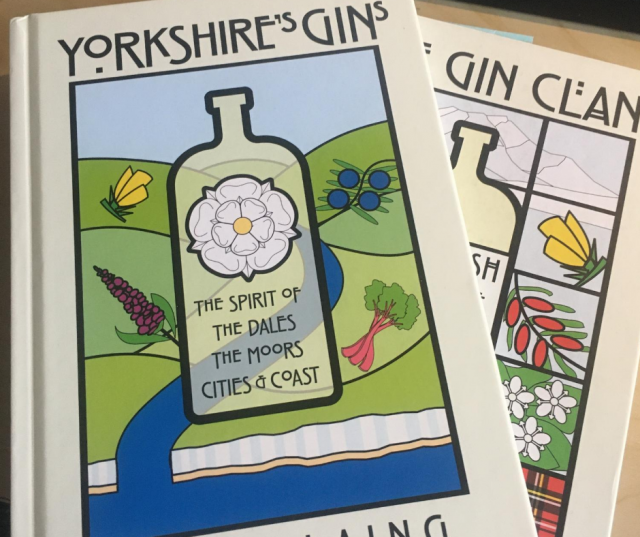Yorkshire’s gin folk
By Fiona Laing – Author of The Gin Clan
It’s Yorkshire Day on 1 August – the day when Yorkshire folk celebrate all that’s good in their county. So it’s a good time to look at what is going on in their gin scene. Fiona Laing who published a book on Yorkshire’s Gins in March takes a look at them for the Scottish Gin Society from a Scottish viewpoint.
The fascination for gin might seems to be a UK wide phenomenon but when you focus on a region you find different forces at work. Take the modern gin scenes in Scotland and Yorkshire.
Scotland is about twice the size population wise and has six times as much land as Yorkshire. So, it is not surprising that there are a great many more gins from Scotland. For my recent book, Yorkshire’s Gins, I found about 60.
The year before in Scotland, for my first book, The Gin Clan, I had 135 entries and by the time I’d written Yorkshire’s Gins there were probably another 60 new Scottish brands (not individual gins) I could have included.
Another difference is history. In Scotland, the modern gin wave dates back to 1999 when Hendricks launched. But it was really a decade later when the perfect storm of distilling tradition, expertise and natural resources made gin making such an attractive option. Caorunn, the Botanist, Darnleys and Edinburgh Gin launched in the two years from 2009.
In Yorkshire, the first gin was only launched in 2013 and more than half of the 60 brands I wrote about had made their debut in 2018 or 2019. Yorkshire’s later boom is due to a combination of factors.
Of course, there was no whisky making tradition in Yorkshire and, as I found when researching The GIN CLAN, several of the early new Scottish gins came from whisky distilleries (all the early ones mentioned above had whisky connections).
Yorkshire is more a beer brewing hotspot with Tetley’s Bitter, Black Sheep John Smith’s, Theakston, Timothy Taylor leading the roll call of familiar pints. And brewing’s influence is strong with brewers launching gins. Andy Gascoigne at the Haworth Steam Brewing Companybeing a good example of brewer-turned-gin – and tonic – maker.
Other gins with ale roots are Black Sheep Dry Yorkshire Gin from the brewery of the same nameand Navigator from Captain Cook Distillery founded by John Toovey who had set up Wainstones Brewery.
Like Scotland, Yorkshire is a food basket. The harvest from the fertile fields and coastal waters, plus the produce from the livestock in the Dales and Moors has helped it become the food capital of England. Rhubarb, liquorish, cheese and beer, are all instantly-recognisable Yorkshire products.
Add to that a culture of appreciating food – and drink – and its provenance. There’s also a vibrant metropolitan cosmopolitan scene where restaurants, clubs and bars flourish. From Michelin-starred restaurants to picture-postcard country pubs, good meals abound. Put this all together and you have a setting ripe for gin.
As in Scotland, gins are made for all sorts of reasons. Yorkshire’s earliest gin, Masons – launched in 2013 – is the classic fan-turns-maker tale. Gin bloggers Karl and Cathy Mason designed a gin, realised it was good and went on to build a distillery in Cathy’s home town, Bedale. It has thrived and despite a catastrophic fire last year, opened a brand new distillery nearby this spring.
Next up was Locksley in Sheffield, where John Cherry used his encounter with craft distilling in the States to follow his dream to build his own distillery. Again – and like many in Scotland – he built his distillery after he had launched his first gin.
In Yorkshire, there are fewer gin distillers with whisky backgrounds and not so many with a formal distillery education. Both those factors run deep in Scotland’s gin scene but their absence hasn’t stopped Yorkshire men and women from making gin.
There are the people who moved from allied sectors – food or drink manufacturing, hospitality – using their insight and skills to create their own gins. Some makers have attended formal courses in distilling; others have self-studied. And interestingly there’s a tradition of people learning the gin-making art from others and then moving on to do their own thing.
For some, a gin is designed to create a sustainable community business or to diversify – or expand – an existing business. A couple are also on the path to making whisky. For others, it is a complete career change. Like Scotland it takes all sorts to make a gin scene.
The two newest distilleries in Yorkshire – both opened in December 2019 – have very different stories.
At Spirit of Swaledale, two friends Ian Purves and Richard Hammond use botanicals that grow near the homes high up in the Dales near Muker in North Yorkshire. Richard, a former chef and publican, and Ian, a doctor and entrepreneur, called on their professional experience to create Spirit of Swaledale Moorland Gin.
The gin quickly found fans but Ian is keen that Spirit of Swaledale creates economic opportunities for the area. There are already branded hats made with wool from Swaledale sheep, and he hopes other products will follow, giving people opportunities beyond farming and tourism.
Meanwhile in Wharfedale at Otley, close to Leeds and Bradford, Nick Jocelyn, a one-time chef, and Nicola Brown, whose grandfather worked for Gilbey’s Gin, were fans first. They developed their passion for the drink into a business, studying and experimenting on a mini still before taking advice from distilling consultant Jamie Baxter.
Determined to make gin in Otley, it took Nick two years before he found the site for his distillery. Its gin now celebrates the market town once famous for having the greatest number of pubs per head in England.
Yorkshire’s Gins and The Gin Clan are available from bookshops across the UK. Scottish Gin Society readers can also buy direct (with free UK p&p) from the publisher, Great Northern Books https://www.gnbooks.co.uk/product/yorkshires-gins-fl/

